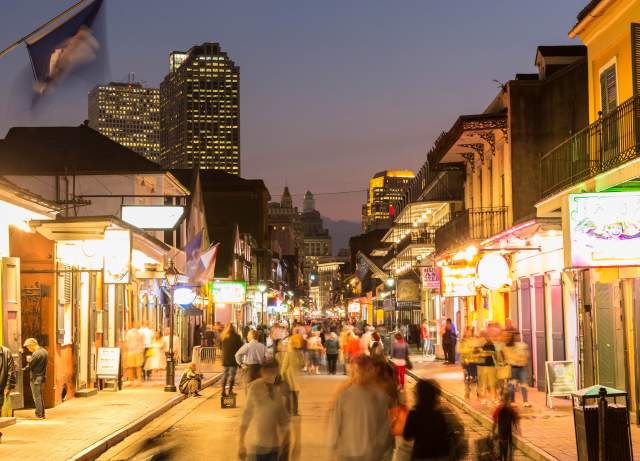Visit Bourbon Street in New Orleans, Louisiana
New Orleans’ famous Bourbon Street is famous for a reason
Noisy. Raucous. Nocturnal. For many New Orleans visitors, Bourbon Street embodies the life of a party town. The street is lit by neon lights, throbbing with music and decorated by beads and balconies. Named for a royal family in France and not the amber-colored alcohol, Bourbon Street has become a place for revelry of all sorts. With its windows and doors flung open to the wandering crowds, it should be no surprise that the famed sidewalk strolling libation known as the “go cup” was invented on Bourbon Street, according to Tulane University historian Richard Campanella. Many things change in New Orleans, but the color and excitement of Bourbon Street never falters.

History
In one of the oldest cities in America, Bourbon Street is rich with historic venues, social tales and iconic buildings. The street dates back to 1718, when New Orleans was founded by Jean-Baptiste Le Moyne de Bienville. French engineer Adrien de Pauger laid out the streets of New Orleans in 1721 and chose one to carry the name of the French royal family ruling at the time, Rue Bourbon. This monumental street is in the heart of the French Quarter extending 13 blocks from Canal Street to Esplanade Avenue before meandering through the Marigny neighborhood.
Points of Interest
One of the most luxurious spots on Bourbon Street, The Royal Sonesta Hotel, opened in 1969. But the hotel’s site dates back to when the city was founded. The land once contained stables, houses and even a brewery. The architectural style of the hotel is unique to New Orleans, as the exterior was designed to look like a typical 1830s row of houses.
Another famous luxury spot on Bourbon is Galatoire’s Restaurant, one of New Orleans’ oldest and most popular restaurants. Founded by Jean Galatoire in 1905, Galatoire’s specializes in French Creole cuisine and is the French Quarter’s hot spot for upscale lunch on Fridays and dinner any night of the week.
Iconic Bars
A favorite spot for both visitors and locals is Jean Lafitte's Blacksmith Shop on the corner of Bourbon and St. Phillip streets. The walls of this Creole cottage bar are full of legends, mystery and days of old New Orleans. The building was constructed sometime before 1772 and is said to be where the Lafitte brothers opened their blacksmith shop as a façade so they could carry out their privateer efforts.
Another cultural staple of Bourbon Street is the Old Absinthe House building, which was built in 1806 as a family-owned importing firm. As years went on, the ground floor became a saloon where in 1874 mixologist Cayetano Ferrer, created the famous Absinthe House Frappe. Today, you can still experience this celebrated drink. The decorative marble fountains that were used to drip cool water over sugar cubes into glasses of Absinthe can still be found here.
The intersection of Bourbon Street and St. Ann Street begins the section of Bourbon that caters to New Orleans’ thriving gay community. Lafitte-In-Exile is the oldest gay bar in the country and Tennessee Williams was a frequent visitor during his time in New Orleans.

Live Jazz on Bourbon
With a walk down Bourbon Street you are bound to hear music on every corner and in between that will make you want to dance the night away (and much of the day). But if you’re looking for some good old-fashioned jazz, you’ll find it at Fritzel’s European Jazz Club. Located in an almost 200-year-old building, Fritzel’s hosts live traditional jazz performances every night of the week and there is no cover charge.
 Cheryl Gerber
Cheryl Gerber
Constant celebrations
Bourbon Street is a prime destination for bachelorette and bachelor parties, birthday celebrations and an overall mecca for those looking to have a good time as they stroll from bar to bar. During the Southern Decadence Festival, which falls around the Labor Day holiday, Bourbon hosts an array of gay-friendly festivities and parties lasting for an entire week. Carnival season in early spring draws thousands of Mardi Gras revelers to the street both night and day. However, you can always enjoy a drink on Bourbon's famous balconies year-round, sing karaoke on stage or ride a mechanical bull as well as appreciate great music.


